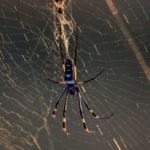 Mysteries
Mysteries  Mysteries
Mysteries  History
History 10 Surprising Stories About the Texas Rangers
 Humans
Humans 10 Philosophers Who Were Driven Mad by Their Own Theories
 Miscellaneous
Miscellaneous 10 Video-Game-Worthy Weapons and Armors from History
 Weird Stuff
Weird Stuff 10 Psychics Who Accurately Predicted Wartime Events
 The Arts
The Arts 10 Pieces of Art Inspired by a Broken Heart
 Health
Health 10 Science Fiction-Sounding New Medical Treatments
 History
History 10 Surprising Facts About the Father of Submarine Warfare
 Space
Space Ten Astonishing New Insights into Alien Worlds
 Weird Stuff
Weird Stuff 10 Bizarre Summer Solstice Rituals Still Practiced Today
 Mysteries
Mysteries Top 10 Haunting Facts About the Ghost Ship MV Alta
 History
History 10 Surprising Stories About the Texas Rangers
 Humans
Humans 10 Philosophers Who Were Driven Mad by Their Own Theories
Who's Behind Listverse?

Jamie Frater
Head Editor
Jamie founded Listverse due to an insatiable desire to share fascinating, obscure, and bizarre facts. He has been a guest speaker on numerous national radio and television stations and is a five time published author.
More About Us Miscellaneous
Miscellaneous 10 Video-Game-Worthy Weapons and Armors from History
 Weird Stuff
Weird Stuff 10 Psychics Who Accurately Predicted Wartime Events
 The Arts
The Arts 10 Pieces of Art Inspired by a Broken Heart
 Health
Health 10 Science Fiction-Sounding New Medical Treatments
 History
History 10 Surprising Facts About the Father of Submarine Warfare
 Space
Space Ten Astonishing New Insights into Alien Worlds
 Weird Stuff
Weird Stuff 10 Bizarre Summer Solstice Rituals Still Practiced Today
Top 10 Astonishingly Beautiful Spiders
Spiders get a bad rap in the animal kingdom, often described as “creepy,” “chilling,” and even “frightening.” Six percent of us are so obsessively afraid of our eight-legged friends, our fear has been dubbed a phobia. The rest of us tolerate them. Their image is not enhanced by their hairy legs, multiple eyes and venom-dripping fangs. This is why they’re a staple of campy horror films and Halloween decor.
But there are spiders that are surprisingly pleasing to the eye. While few of us will likely purchase stuffed likenesses of these spiders to cuddle, it’s hard to argue their beauty.
10 Sparklemuffin
Like most Peacock spiders, Maratus jactatus does an elaborate courtship dance punctuated by leg kicks. Imagine a Rockette who’s forgotten to shave their legs. We’ll see another Peacock spider later. In 2014, Madeline Girard, a graduate student at the University of California, Berkley, discovered this new species[1] in southeast Queensland, Australia. Girard lovingly gave her new find the nickname “Sparklemuffin.”
Mr. Sparklemuffin has a blue and red iridescent belly flap that it raises like a colorful fan to catch the eye of a Ms. Sparklemuffin. When he’s not kicking his leg up, he’s using it and his seven other appendages to rhythmically tap out a message to his perspective mate. Envision a fan and tap dance with can-can kicks. Fortunately for him, Ms. Sparklemuffin has eight eyes[2], giving her a wide-angle view of this dance, as well the ability to see motion. Unfortunately for him, if Ms. Sparklemuffin doesn’t like what she sees, she’ll eat him. Only four of her eyes see forward, the rest giving new meaning to having eyes in the back – and side – of your head. Those eyes can also see a far greater spectrum of colors than the human eye.
Perhaps just as remarkable as Sparklemuffin’s footloose attitude is that his size does not match his audacity. Sparklemuffin measures a mere 4 mm (1/6 of an inch) and could perch comfortably on your pinkie’s fingernail.
9 Brazilian Crab Spider
Epicadus heterogaster is a member of the crab spider family, so-called because their front legs are longer and arch forward instead of downward, giving them a crab appearance. They also can also “crab walk” sideways and backwards. Crab spiders don’t spin webs, but wait until insects come close enough to ambush.
Epicadus heterogaster does this two ways. The smaller juvenile camouflages itself by perching on flowers that match it’s coloring – either white, yellow or purple.[3] It also has an abdominal protuberance that could be mistaken for flower petals. Even its slow, jerky movements look more like foliage swaying in the breeze.
An adult Epicadus heterogaster can also lure insects with a body color that reflects UV light. Scientists discovered this when they applied sunscreen to the back of a female and watched insects ignore it. They are not sure why UV reflective light attracts pollinating insects, but it’s possible the light mimics a flower’s UV color patterns or natural bright spots.[4]
8 Gooty Sapphire Ornamental Metallic Blue Tarantula
First classified in 1899 as Poecilotheria metallica after it was discovered in the Gooty train yard in south central India, this tarantula virtually disappeared for 102 years. Rediscovered in 2001 in a small 100 sq. km (39 sq. mile) forested area in Indias’s Kadapah and Chittoor districts of Andhra Padesh, it quickly became a prized pet for tarantula enthusiasts. Which is both unfortunate and fortunate for this beautiful spider. Andhra Padesh’s forest is quickly degrading due to logging and human encroachment, putting the Gooty Sapphire on the “critically endangered” species list. What was worse, in the years after it was rediscovered, poachers captured these tarantulas to sell. It is now illegal to take Gooty Sapphires out of their natural habitat, but it is legal to purchase domesticated spiders and breed them.[5] Their popularity in Europe and the US may give the species new hope.
In the wild, Gooty Sapphires build funnel webs in the holes of trees, and wait to ambush any insect that comes near. They then bite their prey with their venomous ¾ inch fangs. Which means only experienced tarantula enthusiasts should take a Gooty Sapphire as pets. They’re aggressive and very fast. While their venom is not normally deadly to humans, their bite is painful and will give a human headaches and increased heart-rates for up to a week.[6]
The rich blue and yellow hues of the Gooty Sapphire originates not so much from actual coloring, but from tiny nanostructures on the tarantula’s hairs that bend and reflect blue and yellow light. This means the Gooty Sapphire will appear a different color depending on the angle it is viewed, a trait know as iridescence. Peacocks and dragonflies also have this trait.
7 Sequined or Mirror Spider
Another Australian native, Thwaitesia nigronodosa resides in Queensland’s rainforests. Like most of the various members of the genus Thwaitesia, it has been given the monikers Sequined Spider or Mirror Spider, a reference to its disco ball-like butt. Its trunk is filled with specialized cells called guanocytes, a crystalized version of a digestive waste product – guanine – that the spider would normally poop out. The guanine reflects light making it appear silver, like a mirror, and the combined cells form a sort of poop mosaic. This glittery keister is especially helpful when hiding amongst the rain-glistened foliage of a rainforest.[7]
The Mirror Spider has yet another defense mechanism: if it’s disturbed or must quickly drop from its web, it can immediately hide the guanocyte cells, changing its outer appearance to a drabber hue, like the muddy ground. How it does this is not well understood, but it’s believed it contracts muscles that cover the guanocytes. In short, butt clenches.
6 Elegant Golden Jumping Spider
We’ve known about the beautiful chrysilla lauta for more than 130 years, but it is so rare, and so tiny – a mere few millimeters in size – little is known about it. We don’t know if its beautiful iridescent coloring is for camouflage or catching a mate’s eye. We’re not even really sure what the female of this species looks like.[8]
What we do know is that chrysilla lauta is a member of the jumping spider family and the few videos of it demonstrate that this little guy is a world-class long jumper. There are more than 5,000 species of jumping spiders and make up about 13 percent of all spider species. Even though they have no leg muscles, they can jump 50 times their own length using hydraulic motion. Their hairy legs also give them traction in virtually any terrain including glass.[9] That terrain is usually in the jungles of China, Burma and Vietnam.
10 Fascinating Mysteries Involving Spiders
5 Eight-Spotted Crab Spider
Among the largest crab spiders in the world, Platythomisus octomaculatus can be 7.6 cm ( 3 in) in size. Despite this, they are relatively elusive in the wilds of Southeast Asia stretching from India to Burma to Singapore.[10]
If the name “Eight-spotted” is confusing after counting the spider’s spots, you’re not alone. When the German arachnologist Carl Koch called this species octomaculatus (octo meaning eight) back in 1845, no one seems to know which spots he was counting. His drawings of the species indicates four pairs of abdominal spots, not the three pairs plus an elongated bar we see today. What makes it even more confusing, the number of spots on this spider’s dorsal abdomen changes as it grows. Hatchlings have only two, and, as it ages, acquires more spots not just on the top of its abdomen, but one big one underneath. It also grows six on the forward part of the spider known as the carapace, including the so-called “Panda” spots around its eyes. What’s worse, the size of the spots on the adult female after laying eggs changes significantly. The confusion has led to misidentification of many other species with similar spots.[11]
4 Triangular Spider
We’ve long been aware for a long time that horseshoe crabs were not crabs at all, but it wasn’t until 2019 that scientists parsed it’s DNA to discover it actually was a distant cousin to spiders and scorpions.[12]
If we compared the exteriors of spiders and crabs, it would be easy to believe they were related. They are both arthropods, with their skeletons on the outside (i.e. exoskeletons) and both have jointed legs. And Arkys lancearius – a member of the spider crab family – has the coloring and abdomen shape similar to its crustacean namesake. Even its legs are crab-like. That is until you count the legs: arachnids have eight, crustaceans ten or more. And when we look at the innards of crabs and spiders, we can clearly see they are not really related at all.[13]
Like horseshoe crabs, triangular spiders defy classification. Since it was first described in 1837, Arkys lancearius has been placed in several different families and the debate is still raging. They are common in the warmer environs of Australia and New Zealand and come in either red, yellow, orange, brown, black and white hues.[14] They are ambush hunters, using webbing as safety lines rather than in trapping prey.
3 Long Horned Orb Weaver Spider

Of the 35,000 species of spiders, half of them form webs to catch prey. Perhaps the most recognizable webs are the radial grid ones, made up of concentric circles and held together by spokes. Most of these creations – commonly used in Halloween decorations – are the work of the orb weaver family (Araneidae).[15] The term “orb” can be confusing, as it originates from the old English word for a two-dimensional circle, rather than the modern three-dimensional sphere. With more than 3,000 species, the Araneidae family is the third largest among spiders, and the most diverse in size and appearance.
As if to prove the point, the female Macracantha arcuata sports an impressive pair of antenna-like horns on its abdomen. But those horns are not meant to catch some tunes, but – it’s believed – to make her more intimidating to predators.[16] Those abdomens can either be red, white, black or yellow and the females are often about a centimeter in size. The male is usually a tenth of that in size, which makes him snack-size for the female after coitus.[17] Macracantha arcuata is yet another denizen of the jungles of Southeast Asia, but, because of accidental introductions, can also now be found in Southeast United States.[18]
2 Cat-faced Spider
Another orb weaver, Araneus gemmoides has been dubbed the Cat-faced spider because of the pair of horns on its abdomen that look like a kitty’s ears. Posterior to the horns are eye-like dimples with striations on either side similar to a Tabby’s striped cheeks. To complete the image, the abdomen is covered in tiny fine hairs. Araneus gemmoides comes in various colors ranging from a pale yellow to a dark gray-brown.[19]
The cat-faced spider is fairly common in the western United States, their home stretching from Alaska to California and as far east as Colorado. Both sexes have bulbous butts, but the female’s gets even more bulbous after she mates with (and eats) her paramour. Before the winter frost, Mom is dead, leaving a substantial egg sac chock full of literal ankle-biters. In the spring, the eight-legged babes snack on each other before they hoist silken threads to catch a breeze and carry them elsewhere. The venom of Araneus gemmoides is not dangerous to a human, nor can its fangs pierce the skin. But those fangs can give the back of your hand a severe pinch.[20]
1 Maratus Madelineae
Maratus Madelineae was not given a flashy name like our earlier entry and fellow peacock spider Sparklemuffin, but the story behind its species name illustrates the explosion of interest in peacock spiders in the last decade.
The peacock spider – genus Maratus – was first described way back in 1874, its beautiful, iridescent belly flaps mistaken for wings. While quite common in Australia, little research was done on the tiny spider for over 130 years with only five more species identified during that time. That all changed in 2005 when a mite expert working for the Australian Department of Agriculture, Jurgen Otto, noticed a brownish speck skipping around his feet during a hike (or, in Aussie parlance, a bushwalk). Otto was an entomologist concerned with six-legged bugs and had never heard of a peacock spider, so he took it to Julianne Waldock, an arachnologist at the West Australia Museum. Waldock had spent the previous decade studying Maratus and it was she who believed the little guy danced and hoisted their colors not to fly but to gain a dance partner.
Otto was enthralled, filling his home with 300 captured peacock spiders. Otto was also an avid photographer and his pictures caught the attention of a South Carolina jumping spider expert, David Hill.[21] In 2011, Otto used a macro lens to capture a peacock spider’s dance, and created a YouTube video complete with the Bee Gee’s Staying Alive soundtrack and photoshopped maracas. It garnered 7.5 million views. People couldn’t get enough of the cute little guy.
That same year Otto and Hill described and named their first new Maratus species. In the next eight years, they would name 46 more. Waldock would name nine. What’s more, Otto’s YouTube video inspired hordes of amateur scientists and photographers to descend on Australia in search of the tiny dancers. For instance, Maratus Harrisi was named after an amateur photographer, Stuart Harris, simply posted a photo of a peacock spider on Flickr only to find out it was an undiscovered species. Otto, too, has a peacock spider named after him (Maratus Ottoi) as does Waldock (Maratus Julianneae). And Maratus Madelineae is named after Madeline Girard who gave Sparklemuffin its name.[22] In total, 71 species of peacock spiders were discovered and named between 2011 and 2019.
When Maratus Madelineae dances, it doesn’t just kick a leg up like his cousin Sparklemuffin, but raises two appendages over its head, waving them like he just don’t care. And sometimes he brings them together as if he were clapping. Just below its eyes and covering what would be our mouth are a pair of secondary legs known as pedipalps or just palps. On Maratus Madelineae the palps are white and hairy, looking for all the world like an old man’s beard. And when he dances, he rhythmically bobs those palps, looking like an old man chewing on his dentures. In his video, he looks a little like grandpa attempting the hokey-pokey.
As a final note, for those few who do want a cuddly, stuffed spider toy, they really do make a felt wool-stuffed Maratus Madelineae for your enjoyment. And you can buy a stuffed Sparklemuffin too.[23]
About the author: Steve is the author of the bestselling biography “366 Days in Abraham Lincoln’s Presidency” and several not-so-bestselling novels, unrecognized (probably because they’re also unpublished) for their literary contribution to the garbage bin.








